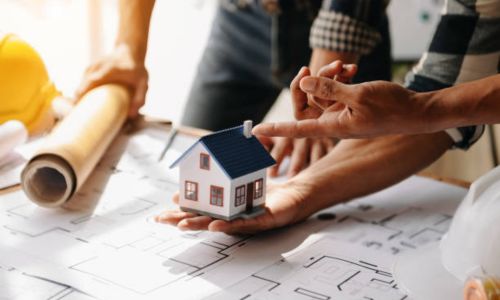Latest Trends in Home Construction and Design (2025)
The home construction and design world is evolving rapidly, driven by changes in technology, lifestyle,
environmental awareness, and a renewed focus on personal well-being. Whether planning to build a new home or renovate an existing one, staying
up-to-date with the latest trends ensures that your space is functional,
stylish, and future-ready. In this blog, we'll explore the most significant
trends shaping home construction and design in 2025.
Sustainable and Eco-Friendly Construction
Sustainability is no longer a
buzzword—it's a necessity. Homeowners are increasingly demanding green building
practices, and construction companies are rising to meet this demand with
innovative, eco-conscious solutions.
Key Features:
Use
of recycled and renewable materials (bamboo, reclaimed wood, recycled steel)
Energy-efficient
windows, insulation, and HVAC systems
Solar
panels and green roofs
Rainwater
harvesting systems
Net-zero
energy homes
Why It Matters: Sustainable construction reduces environmental impact,
lowers utility bills, and increases long-term property value. Governments and
financial institutions are also offering incentives for green building
practices.
Smart Home Integration
Technology continues to transform
homes into intelligent living spaces. In 2025, smart homes are more than just a
trend—they are becoming the standard.
Popular Smart Features:
Voice-controlled
lighting and appliances
Smart
thermostats and climate control
Security
systems with facial recognition and remote monitoring
Automated
blinds and smart glass
Integrated
home hubs (Google Home, Amazon Alexa)
Why It Matters: Smart home technology improves convenience, enhances
security, and contributes to energy efficiency. It also offers customization
options that cater to individual preferences.
Open Floor Plans with Defined Spaces
While open floor plans remain
popular for their spacious feel and natural light, there's a growing desire to
create more defined functional areas within these layouts.
Emerging Ideas:
Sliding
partitions and glass walls
Multi-functional
furniture for zoning
Strategic
use of rugs, lighting, and ceiling treatments to define spaces
Why It Matters: The pandemic has redefined how we use our homes. With more
people working, studying, and exercising at home, there's a need to balance
openness with privacy.
Biophilic Design
Biophilic design incorporates
natural elements into the built environment to create a sense of harmony and
improve mental well-being.
Common Elements:
Indoor
gardens and green walls
Natural
light and ventilation
Use
of wood, stone, and water features
Large
windows with views of nature
Why It Matters: Biophilic design promotes relaxation, reduces stress, and
boosts productivity. It's especially relevant in urban settings where access to
nature is limited.
Multifunctional Spaces
Homes are increasingly designed for
flexibility. Whether it's a guest room that doubles as a home office or a
kitchen island that functions as a workspace, multifunctionality is key.
Trends in Space Utilization:
Murphy
beds and foldable furniture
Built-in
desks and office nooks
Hybrid
indoor-outdoor spaces
Convertible
dining and work areas
Why It Matters: Maximizing functionality without increasing square footage
is a smart way to adapt to changing needs and lifestyles.
Minimalist Aesthetic with Warm Textures
Minimalism remains a strong
influence, but 2025 introduces a warmer, more inviting version of the style.
Design Features:
Neutral
color palettes with earthy tones
Soft
textures like boucle, linen, and natural wool
Clean
lines with organic curves
Less
clutter, more statement pieces
Why It Matters: This approach creates a soothing environment without
feeling sterile. It's about achieving balance and calm through design.
Energy-Efficient and Resilient Design
As climate change accelerates,
homeowners are seeking not only efficiency but also resilience in their home
designs.
Key Trends:
Passive
solar design
Advanced
insulation and thermal mass
Fire-resistant
and flood-resistant materials
Backup
power systems (solar batteries, generators)
Why It Matters: Building homes that can withstand extreme weather and
reduce dependence on external utilities is becoming increasingly crucial.
Modular and Prefabricated Construction
Off-site construction methods are
gaining popularity for their speed, cost-effectiveness, and sustainability.
Benefits of Modular Construction:
Reduced
construction time and waste
Precision
manufacturing and quality control
Easier
customization and scalability
Why It Matters: With labor shortages and supply chain disruptions,
prefabrication offers a viable solution for efficient and affordable home
building.
Luxury Kitchens and Spa-Like Bathrooms
Kitchens and bathrooms continue to
be focal points for homeowners. The trend is towards creating high-end,
personalized experiences.
In the Kitchen:
Smart
appliances and touchless technology
Hidden
storage and walk-in pantries
Waterfall
countertops and bold backsplashes
In the Bathroom:
Freestanding
tubs and rain showers
Natural
materials and mood lighting
Heated
floors and towel racks
Why It Matters: These upgrades enhance daily comfort and add significant
value to the home.
Local and Culturally-Inspired Design
Homeowners are increasingly looking
to reflect local culture, history, and craftsmanship in their homes.
Examples:
Traditional
Kerala-style roofing and courtyards
Locally
sourced materials like laterite stone or terracotta tiles
Regional
art, textiles, and hand-crafted decor
Why It Matters: Cultural elements bring authenticity and personal meaning
to a home while supporting local artisans and traditions.
Final
Thoughts
The future of home construction and
design is rooted in adaptability, sustainability, and personalization. Whether
you're building from the ground up or making thoughtful renovations,
incorporating these trends ensures your home meets modern standards while
remaining comfortable, beautiful, and enduring.
Staying informed about industry
trends not only helps you make better decisions but also positions your
property for long-term value. If you're planning a project, consider working
with professionals who understand and implement these latest innovations to
bring your vision to life.
Meet your unique requirements. To Learn More, Visit Our Website




Comments
Post a Comment